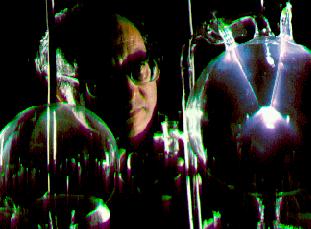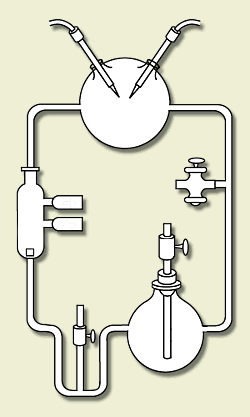

Stanley Miller (then a graduate student working with H. Urey at the University of Chicago) tried to re-create these conditions in the laboratory. (L. E. Orgel, http://www.geocities.com/CapeCanaveral/Lab/2948/orgel.html)
 |
Here is a sketch of his apparatus. (S. Henehan, http://www.accessexcellence.org/WN/NM/miller.html) He warmed a soup of chemicals thought to be abundant on the early earth, circulated them through a region where they were subject to electric sparks (simulating lightning) and cooled them and returned the products to the soup. Within a few days, the soup was rich in animo acids, the building blocks for life -- 15% of the carbon was in these acids! It turned out to be so easy to make animo acids, we assume something similar happened on the early earth.
|
Eventually, at some place on the earth, animo acids became organized into the much more complex structures that are required for life. Proteins are the main building material for living organisms, but cannot reproduce. RNA (ribonucleic acid, the complement to the DNA that carries the genetic code for us) was essential for that function. The first very primitive organisms would have been too small and fragile to leave fossils, but the whole chain of transformations must have proceeded rapidly (on a geological time scale) to produce the varieties of primitive life only a few hundred million years after the asteroid bombardment stopped. It has proven difficult to produce primitive RNA through experiments analogous to Miller's, so our understanding of this key step is not very complete. Once it had occurred, we had life!